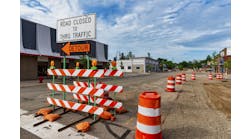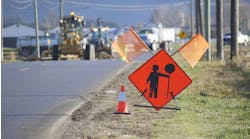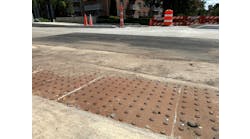Traffic calming was born in the streets of the Netherlands in the late 1960s as a reaction to the rapid increase in traffic volumes and the accompanying deterioration in the livability of post-World War II Dutch cities. At the time, the idea of placing obstacles in the roadway to restrain traffic speeds and flow was considered to be extremely radical—even in the Netherlands. However, by the mid-1970s traffic calming had been adopted as official Dutch government policy for design and had spread to surrounding northern European countries and even to America in places like Berkeley and Seattle. It may have taken 40 years, but the engineering establishment in the U.S. has slowly come to accept traffic calming as a part of the tool box for street design—at least for use on local streets.
While we in the U.S. have been cautiously grappling with how and where to use traffic calming, the Dutch and their northern European neighbors have continued to experiment and innovate in finding constructive ways to accommodate cars in their cities. Designers in these countries have been motivated both by the desire to enhance living conditions in their cities and to increase safety for all road users. It is worth noting that in 1970, the fatality rate per capita in the Netherlands and the U.S. was almost identical. Now the Dutch rate is 2.5 times less than that in America. What is interesting is that Dutch engineers do not seem to consider this dramatic progress to be good enough: Now the goal in countries like the Netherlands and Sweden is to actually eliminate traffic fatality as a factor in everyday life.
Everybody has a piece
Out of this innovative environment has emerged a new concept for street design that is variously referred to as legible streets, self-explaining streets or shared streets. In the United Kingdom, some publications have even taken to using the term “naked streets” in reference to the fact that a feature of these streets is that they have been “stripped” of the signs and markings that are necessary for the operation of conventionally designed streets. The thinking is that shared streets do not need signs and markings, because users are guided on their proper use by the physical design of the streets themselves.
The salient feature of shared streets is not just that they are “naked,” but that they are designed to be fully part of the public realm and not just a conduit for traffic. In other words, the whole right-of-way of the shared street is designed to be an integral extension of the surrounding land-use context. Therefore, all users have equal access. A vehicle is considered to be just another user that must negotiate space on an equal footing with shoppers, bikers, skaters and pedestrians. The idea is to make the street legible so that the users can understand that it is a shared environment and then behave accordingly.
Ben Hamilton-Baille, a UK designer who has studied shared streets all over northern Europe, reported on an intersection in Christiansfeld, Denmark, that was converted to a shared street in order to address safety concerns. The original intersection was a conventional one with traffic signals and the requisite signs. The idea for the redesign was to create a sense of place at the intersection through the use of appropriate surface treatment, lighting columns and squared-off corners at the crossroads. According to Hamilton-Baille, these changes result in an intersection that now feels like a town center. Data from the Danish Traffic Directorate shows that in the three years since the conversion there have been no serious injury accidents at this intersection, compared with an average of three injury accidents per year before conversion. More surprisingly, traffic backups during peak hours have actually decreased. The data suggest that the new intersection has improved capacity and results in fewer delays than the original traffic-signal controlled intersection.
The best-known designer of shared streets is the Dutch engineer Hans Monderman, who works in the northern Dutch province of Friesland. In 1998, Monderman converted an intersection know as “de Brink” from a conventional signal-controlled intersection to a simple brick-paved intersection that has been stripped of signals, signs, markings and barriers. Hamilton-Baille reported: “While observing the workings of ‘de Brink’ in the center of the Friesland market town of Oosterwolde, I was intrigued to hear a traffic engineer and safety official remark, with satisfaction, how many ‘traffic violations’ were taking place each moment in the raised paved stage-like square that constitutes the new intersection. Trucks, bikes, cars and pedestrians intermingle with apparent chaos and disorder using eye contact and careful observation to negotiate space. The guiding control of the state is absent: it relies entirely on informal conventions and legibility.”
“De Brink” is a fairly quiet intersection with only 4,500 cars per day. In sharp contrast the “Laweiplein,” which is a major intersection in the Friesland city of Drachten, carries almost 20,000 cars per day. In 2003, Laweiplein was converted from an unattractive, signal-controlled intersection to a shared-street intersection. The Laweiplein is now a textured intersection where the sidewalk merges with the roadway. At the center is a roundabout, which is delineated by a contrasting surface treatment, and at each of the four corners of the intersection there are fountains that are lit at night. According to city engineer Koop Kerkstra, accident rates have fallen about 20% since the conversion, and travel time for crossing the city has improved dramatically. This apparent success of the Laweiplein conversion suggests that shared streets are not just for low-volume local streets.
Numerous shared-street projects are now in place across the Netherlands, Scandinavia and the United Kingdom. The consensus report is that these conversions have significantly increased safety and also have improved traffic flow efficiency. The primary explanation for these somewhat counterintuitive outcomes is that the shared-street environment reduces vehicle speeds generally to less than 20 mph.
From the point of view of traffic safety, research in the U.S. and Europe has long shown that 20 mph is an important threshold. Below 20 mph the chance of being severely injured in a traffic accident is relatively low. But 20 mph also is the threshold speed at which people are able to interact and maintain eye contact and pedestrians and bicyclists feel comfortable in a mixed-use environment. These factors taken together explain why a number of European cities have begun to institute a uniform speed zone of 19 mph in their built-up area.
The greater efficiency of traffic flow on shared streets also is attributed to the low-speed environment. The theory is that intersections, which are usually the bottlenecks in built-up areas, function much more efficiently at lower speeds since traffic signals are not needed. This theory seems to be borne out in many instances where cities have instituted area-wide 19-mph speed zones and have found that the traffic moved much more smoothly.
Not quite calm
The concept of shared streets has many of the same goals as does traffic calming, but the approach to achieving those goals is quite different. Although traffic calming is typically based on adding devices to the roadway to slow or restrict traffic, it still relies on conventional traffic operational principles. In other words, the assumptions in traffic calming are (1) that the pavement is for traffic and the sidewalk is for pedestrians and (2) that signs and markings are needed to regulate behavior. The concept of shared streets represents a break from these essentially conventional assumptions.
In the American context, the idea of shared streets (especially for busier urban streets) is probably as radical a concept as traffic calming seemed 40 years ago when it first appeared in the Netherlands. The shared-street concept challenges prevailing orthodoxy about how streets are designed and about traffic safety. The idea of regulating traffic and separating users in time or space is very ingrained into our design philosophy. The apparent success with shared-street design in north Europe raises the question of whether the conventional approach to street design needs to be reconsidered both from the perspective of place making and safety.
The advocates for shared streets are exhorting us to “do it in the streets.” In other words they are saying we need to recapture the vehicle right-of-way and make it an integral part of the public realm. Given the existing regulatory framework for design in the U.S., I am not so sure we are in a position to fully embrace this philosophy on any but the most local of streets. But the success that countries like the Netherlands have had in reducing traffic fatalities and in enhancing the vitality of their cities lends the credibility that suggests we need to be open to learning more about their approach to street design. Shared streets rely on social rather than regulatory controls to govern how all users behave. There is a growing body of data to show that in situations where there is a mix of different types of users, this design approach can be the most effective for safety and efficient traffic movement.
The last decade has seen an explosion in the design of mixed-use environments in the U.S. For one, the new urbanist and the smart-growth movements have brought about an appreciation of place making and the need to move away from auto-dominated, segregated, single-use development in favor of more walkable, mixed-use communities. In addition, more and more places are incorporating light rail, bicycles and pedestrians into their transportation traffic mix. With these changes the prevailing approach to street design, which focused on servicing auto-oriented development, is no longer relevant in many places. As engineers seek better ways of accommodating the new paradigm in American place making, the concept of shared streets, as being practiced in Europe, might contain important pointers on designing streets for the new mixed-use, walkable American city.


